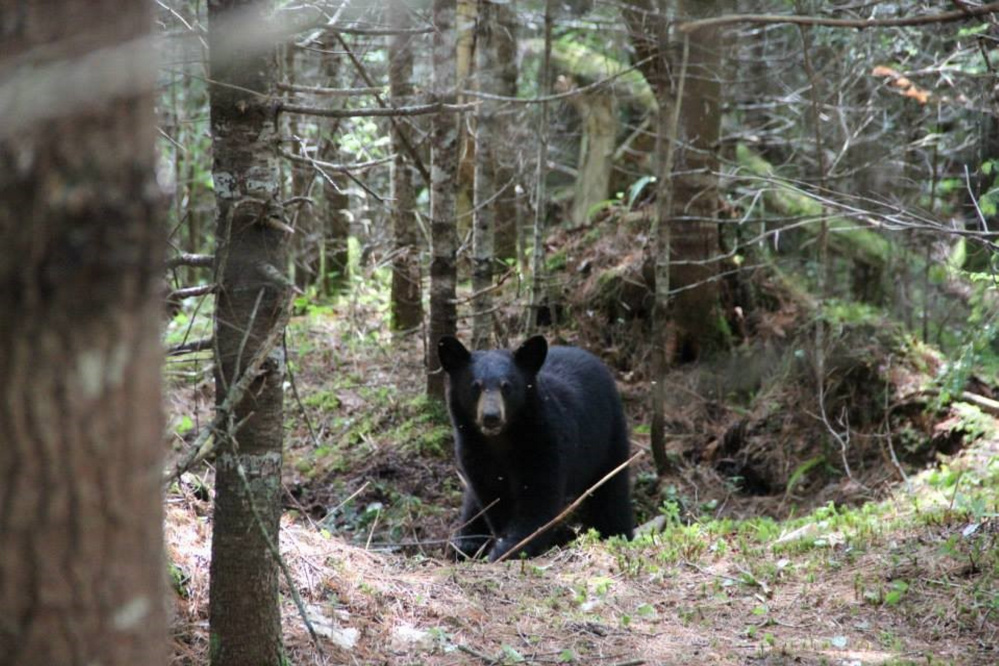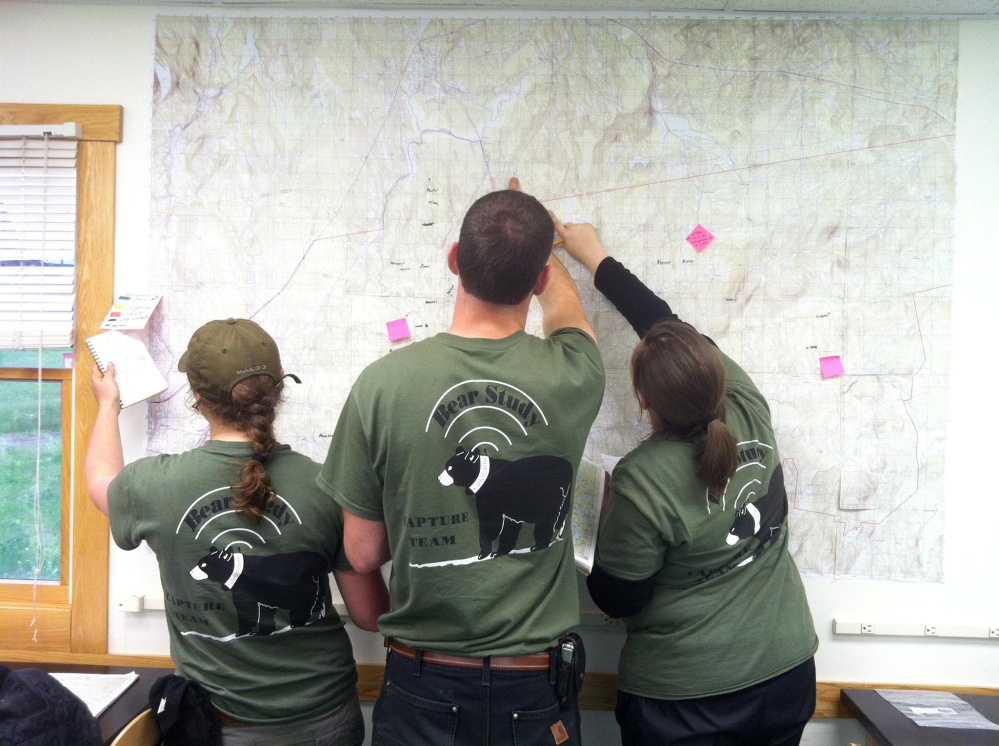UNITY — The bears are back.
That’s the takeaway from a three-year study into the black bear population in central Maine recently completed by Unity College.
Unity students, with support from faculty advisers and the Maine Department of Inland Fisheries and Wildlife, trapped, weighed and tagged male and female bears focusing on the area around Unity in northwestern Waldo County.
Through the study students recovered a treasure trove of biological data that they are now using in their academic research.
But the program also provided a rare glimpse into a black bear population that is slowly recolonizing an area that likely hasn’t had a permanent bear presence for more than a century.
“Unity College has enabled us to gather some data on recolonizing bears we would be hard-pressed to accomplish with our time and budget,” said Randy Cross, a wildlife biologist who oversees the state Department of Inland Fisheries and Wildlife bear research team.
Although the study has provided valuable scientific information and a unique hands-on experience for undergraduate students, the college this year canceled the funding, although it is actively looking for external sources to support the work.
“I’m unaware of any other undergraduate program that is doing something like this,” said George Matula, a wildlife biologist at Unity who helped coordinate the student-led study.
“I’m glad it went as well as it did for the three years we had it, and I hope it continues,” Matula said.
‘NOT A TREE TO HIDE IN’
Since May 2013, the Unity team captured 23 different bears, including five females that were collared, according to the study. In February, the team tracked down two collared females in their winter dens and tagged four cubs, two from each female. That the team found bears in the area at all was a surprise, Matula said. When he pitched the idea to IF&W, biologists thought they would be lucky to trap one or two bears at best, he recalled.
“What we are essentially looking at is a population of bears that are just now recolonizing,” Matula said.
In the mid-1800s, the Unity area, like most of central and western Maine, was largely fields and other agricultural land, an inhospitable terrain for black bears.
“In the late 1800s, there wasn’t even a tree left for a bear to hide,” said Cross, the state biologist.
As agriculture faded, the woods grew back, but it took a lot longer for bears to return. Male bears have a wide range. The Unity team recorded in 2014 one male that in less than two weeks traveled an area of more than 500 miles and crossed Interstate 95 six times and the Sebasticook and Kennebec rivers twice each.
Females on the other hand can spend their entire lives within 10 miles of where they were born, Cross said. That means it takes a long time for the animals to spread out from habitat farther north.
“Once they are eliminated from an area, they are very slow to pioneer back,” Cross said.
However, a bear population boom in the last decade could be leading animals farther south.
According to the department’s 2014 research and management report, the bear population grew from 23,000 in 2004 to more than 30,000 in 2010. The number of bears being killed by hunting — the primary means of population management — every year is less than the number needed to maintain a stable population, Cross said.
“The last 10 years has been the greatest population growth for bears in the entire state,” Cross said. “That’s what provides forward pressure, so to speak.”
UNIQUE STUDY
The IF&W maintains three research areas with dense bear populations, one near LaGrange and Edinburg in the Penobscot River valley, another north of Route 9 in Washington County and the third in the north woods west of Ashland. It doesn’t have the resources to track the expansion of the bear population farther south, Cross said.
That’s what makes the information gathered by the Unity study unique.
“It is pretty clear to us that they are not just there in the Unity College area, but in all of the country that was relatively unoccupied 40 years ago,” Cross said. “The appearance is that the influx is overcoming the high mortality rate that Unity College has been able to document.”
One of those sources of mortality appears to be vehicle collisions. According to data from the Maine Department of Transportation acquired by Unity students, there were 18 bear-vehicle collisions in wildlife management district 23, which includes the Unity area, since 1992. According to the study, 10 of the collisions were recorded between 2010 and 2014, and three bears killed by cars were tagged by the Unity team.
Brenda and Stephen Cole, who live in Thorndike, are registered Maine Guides who have been leading bear hunts from their Spruce Mountain Lodge in Washington County near the Canada border for the last 20 years.
The couple are accustomed to seeing bears, but in the last decade or so the population has exploded, Brenda Cole said.
In the past five years or so, she has started to see more bear markings around her home. One of her friends has even asked if she should let her dogs out during the day because of the bears, she said.
“A lot of people do not realize how many bear there are, and I feel their population has grown. I feel like they are moving this way because they are getting pushed,” she said.
The booming bear population has been good for business, drawing in hunters from out of state, but Cole said she won’t be organizing hunts around central Maine anytime soon. The area is densely populated compared to the remote woods around their lodge, and neighbors likely won’t want bears attracted to bait areas near their homes.
Bear baiting became a hot-button political issue in 2014, when a citizens’ referendum heavily supported by the Humane Society of the United States proposed banning hunting bears with bait, dogs or traps. The proposal drew a backlash from hunting advocates and staff at the Department of Inland Fish and Wildlife, who openly lobbied against the referendum. Voters rejected the referendum at the ballot last November. The department is starting to gather information to create a new management plan that could include increasing the number of bear killed annually.
“You have to keep it in check,” Cole said. “A lot of people don’t agree with that, but if you don’t, mother nature will take over.”
HANDS-ON EXPERIENCE
The Unity study provided unique data for state biologists, but it also gave students personal experience they wouldn’t be likely to get outside of graduate work, Matula said. That falls in line with the college’s goal to give students experiential learning, but it also gave students who worked on the program a leg-up on their professional goals.
Brandon Cross, a senior, worked on the study for two years, first as an intern and then as one of the leaders of the capture team last summer. In his position he oversaw three interns and was in charge of daily tasks like getting vehicles ready, setting out bait, tagging animals and collecting data. The hands-on experience is why he stuck with the program, Cross said.
“That’s something you can’t get in a classroom,” he said.
The teams also collected reams of data, biological samples, GIS information and even video from a camera attached to a bear that Unity students will be able to dissect and study to dig deeper into bear habits and behavior.
For example, one of the findings of the study was that females were giving birth at two years old, significantly younger than bears in the IF&W study areas. One of the team leaders, Jonah Gula, theorized in his senior thesis that the early birth could be related to females’ apparent preference for wetland habitats that could have high-quality vegetation, according to the report.
According to Brandon Cross, there are more than 100 Unity students now working with the data the study developed.
“It’s amazing the stuff we collected and what they are able to do with it,” he said. “Even though the bear study has ended, they can still use that data we collected for years.”
But even with the amount of information the study provided, it will take more time to begin to draw strong conclusions, according to Matula.
“It’s going to take several years to make a lot of really good conclusive comparisons, but there are some intriguing comparisons,” he said.
The study might not have a few more years.
According to Unity College spokesman Bob Mentzinger, the project cost Unity about $120,000 or $40,000 a year. When the school announced the third year findings, it also announced it would seek other sources of fininancing for the program.
“The study was always considered to be a pilot project, as the college provided the money out of a strategic initiatives fund with the intention to draw external funding in the out years,” Mentzinger said.
The college so far hasn’t been able to identify new sources of revenue aside from a $15,000 grant from the Maine Outdoor Heritage Fund, but it is actively looking and expects to be able to offer the study again in the future, he said.
Peter McGuire — 861-9239
Send questions/comments to the editors.






